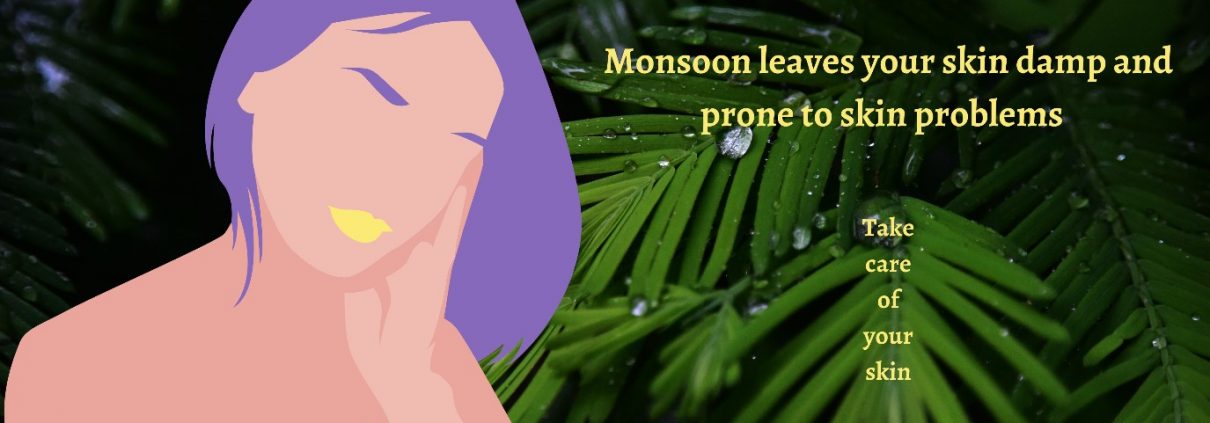Skin Problems in Monsoon
Everyone loves monsoon. It is a season when greenery is everywhere; you can feel the pleasant wind and earthy smell. Everything is clean and pure. There is a sudden drop in temperature when the monsoon arrives right after the summer.
Despite all these pleasing experiences, it is a period of medical issues like skin infections and allergies as well. The common conditions during this time of the year are fungal infections and bacterial infections.
The high humidity in monsoon season promotes sweating and accumulation of moisture on the skin. It leaves the skin damp and provides an ideal condition for fungal growth and causes incredibly itchy skin rashes.
We find a lot of fungal infections, between the fingers, in the groin area, in the armpits and beneath the breast tissues. These areas are particularly prone to infection because sweat tends to stay on the skin for a more extended period in these areas. The infection appears as a red rash which can be roundish with a well-defined edge to it and continuous itching.
The other common problem that one sees during this time of the year is bacterial skin infections. Due to the high level of humidity, we all tend to scratch on our skin.
Scratching of the skin causes slight damages like cuts and wounds on your skin which are invisible to the naked eye. However, these small cuts and wounds allow the bacteria which stays on the surface of your skin to penetrate deeper into the skin and cause an infection.
This infection can appear as a small red pimple-like lesion. It may become more extensive, or it may become a red patch.
There is a difference between bacterial infections and fungal infections. The bacterial skin infections tend to be more painful in contrast to fungal skin infections which tend to be itchy.
Common fungal and bacterial infections in monsoon-
- Athlete’s foot- You will see itchy, flaky, white blisters and cracks in your toes and under the feet. It is an infectious fungal disease.
- Tinea fungal infections- These infections are highly contagious and include itching with them. Ringworms, Tinea capitis and Onychomycosis are examples of this type of conditions.
- Pyoderma- It is a skin infection that also causes pus.
- Folliculitis- This fungal or bacterial infection occurs in your hair follicles. It can trigger painful red pimple.
- Eczema- During this skin condition, your skin becomes patchy and red due to infection. You may see dry and rough scales on the infected portion.
- Scabies- These are the microscopic mites. They burrow in your skin and lay eggs. It causes redness and uncontrollable itching.
- Nail infections- Wearing closed shoes for an extended period, and stagnant rainwater can cause painful infections to your nail.
Treatment for fungal infections-
The treatment of these fungal infection depends upon the extent of the condition. If it is a very mild infection covering a tiny area of the skin, then an antifungal ointment or cream will do the trick.
If the fungal infection is widespread and involves large parts of the body, then one may need anti-fungal medications. Besides, it is essential to keep the area dry as much as possible.
That is whenever you take a bath or come back from swimming always dry out your body to avoid the accumulation of moisture. In the night, it is advisable to wear loose cotton or lining undergarment and nightclothes. Because these parts of your skin need adequate ventilation and there is as little accumulation of moisture as possible in these areas.
There are a lot of antifungal powders available in the market. We can use these antifungal powders to prevent the development of fungal infections. Very often, doctors recommend this antifungal dusting powder to people who are prone to develop fungal infections. People who are overweight, have insufficient nutritional status or diabetes are at more risk to this kind of fungal infections.
Some people develop skin infections during the monsoon season every year. The antifungal powder can work for them also as a preventive measure.
Treatment for bacterial infection-
The treatment of bacterial skin infections is reasonably straight forward and simple. If it is a small area, an antibiotic ointment or cream will solve your problem.
However, if the condition is extensive or if the disease affects your head and the neck area, then it is advisable to see a dermatologist.
It would be best if you get a prescription for oral antibiotic medicines from the dermatologist. Further, you should not discontinue your medication without your doctor’s advice. Because very often if the antibiotic is discontinued before completing the course, there is a scope of recurrence of the infection.
We at Dr Swetha Cosmoderm Centre would strongly recommend you to see a dermatologist and have a proper examination of your issue. Some skin problems tend to cause irreparable damage to your skin.










Leave a Reply
Want to join the discussion?Feel free to contribute!